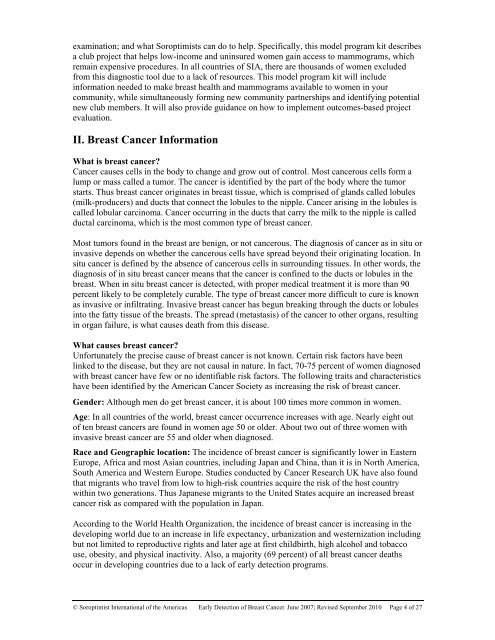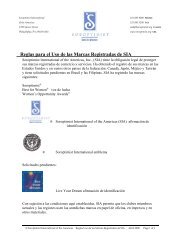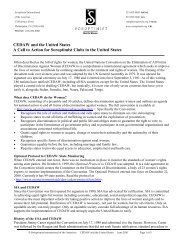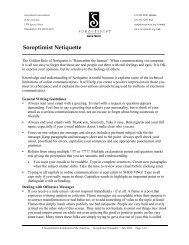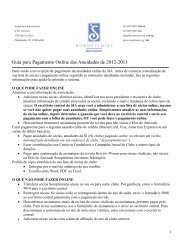Early Detection of Breast Cancer - Soroptimist
Early Detection of Breast Cancer - Soroptimist
Early Detection of Breast Cancer - Soroptimist
You also want an ePaper? Increase the reach of your titles
YUMPU automatically turns print PDFs into web optimized ePapers that Google loves.
examination; and what <strong>Soroptimist</strong>s can do to help. Specifically, this model program kit describes<br />
a club project that helps low-income and uninsured women gain access to mammograms, which<br />
remain expensive procedures. In all countries <strong>of</strong> SIA, there are thousands <strong>of</strong> women excluded<br />
from this diagnostic tool due to a lack <strong>of</strong> resources. This model program kit will include<br />
information needed to make breast health and mammograms available to women in your<br />
community, while simultaneously forming new community partnerships and identifying potential<br />
new club members. It will also provide guidance on how to implement outcomes-based project<br />
evaluation.<br />
II. <strong>Breast</strong> <strong>Cancer</strong> Information<br />
What is breast cancer?<br />
<strong>Cancer</strong> causes cells in the body to change and grow out <strong>of</strong> control. Most cancerous cells form a<br />
lump or mass called a tumor. The cancer is identified by the part <strong>of</strong> the body where the tumor<br />
starts. Thus breast cancer originates in breast tissue, which is comprised <strong>of</strong> glands called lobules<br />
(milk-producers) and ducts that connect the lobules to the nipple. <strong>Cancer</strong> arising in the lobules is<br />
called lobular carcinoma. <strong>Cancer</strong> occurring in the ducts that carry the milk to the nipple is called<br />
ductal carcinoma, which is the most common type <strong>of</strong> breast cancer.<br />
Most tumors found in the breast are benign, or not cancerous. The diagnosis <strong>of</strong> cancer as in situ or<br />
invasive depends on whether the cancerous cells have spread beyond their originating location. In<br />
situ cancer is defined by the absence <strong>of</strong> cancerous cells in surrounding tissues. In other words, the<br />
diagnosis <strong>of</strong> in situ breast cancer means that the cancer is confined to the ducts or lobules in the<br />
breast. When in situ breast cancer is detected, with proper medical treatment it is more than 90<br />
percent likely to be completely curable. The type <strong>of</strong> breast cancer more difficult to cure is known<br />
as invasive or infiltrating. Invasive breast cancer has begun breaking through the ducts or lobules<br />
into the fatty tissue <strong>of</strong> the breasts. The spread (metastasis) <strong>of</strong> the cancer to other organs, resulting<br />
in organ failure, is what causes death from this disease.<br />
What causes breast cancer?<br />
Unfortunately the precise cause <strong>of</strong> breast cancer is not known. Certain risk factors have been<br />
linked to the disease, but they are not causal in nature. In fact, 70-75 percent <strong>of</strong> women diagnosed<br />
with breast cancer have few or no identifiable risk factors. The following traits and characteristics<br />
have been identified by the American <strong>Cancer</strong> Society as increasing the risk <strong>of</strong> breast cancer.<br />
Gender: Although men do get breast cancer, it is about 100 times more common in women.<br />
Age: In all countries <strong>of</strong> the world, breast cancer occurrence increases with age. Nearly eight out<br />
<strong>of</strong> ten breast cancers are found in women age 50 or older. About two out <strong>of</strong> three women with<br />
invasive breast cancer are 55 and older when diagnosed.<br />
Race and Geographic location: The incidence <strong>of</strong> breast cancer is significantly lower in Eastern<br />
Europe, Africa and most Asian countries, including Japan and China, than it is in North America,<br />
South America and Western Europe. Studies conducted by <strong>Cancer</strong> Research UK have also found<br />
that migrants who travel from low to high-risk countries acquire the risk <strong>of</strong> the host country<br />
within two generations. Thus Japanese migrants to the United States acquire an increased breast<br />
cancer risk as compared with the population in Japan.<br />
According to the World Health Organization, the incidence <strong>of</strong> breast cancer is increasing in the<br />
developing world due to an increase in life expectancy, urbanization and westernization including<br />
but not limited to reproductive rights and later age at first childbirth, high alcohol and tobacco<br />
use, obesity, and physical inactivity. Also, a majority (69 percent) <strong>of</strong> all breast cancer deaths<br />
occur in developing countries due to a lack <strong>of</strong> early detection programs.<br />
© <strong>Soroptimist</strong> International <strong>of</strong> the Americas <strong>Early</strong> <strong>Detection</strong> <strong>of</strong> <strong>Breast</strong> <strong>Cancer</strong> June 2007; Revised September 2010 Page 4 <strong>of</strong> 27


